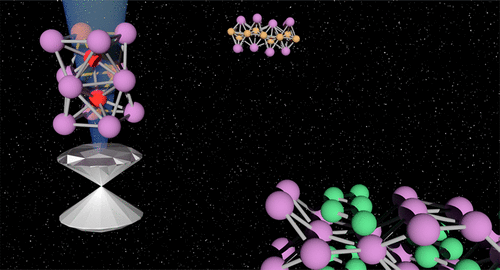当前位置:
X-MOL 学术
›
Acc. Chem. Res.
›
论文详情
Our official English website, www.x-mol.net, welcomes your feedback! (Note: you will need to create a separate account there.)
High-Pressure Synthesis: A New Frontier in the Search for Next-Generation Intermetallic Compounds
Accounts of Chemical Research ( IF 18.3 ) Pub Date : 2018-05-29 00:00:00 , DOI: 10.1021/acs.accounts.8b00143 James P. S. Walsh 1 , Danna E. Freedman 1
Accounts of Chemical Research ( IF 18.3 ) Pub Date : 2018-05-29 00:00:00 , DOI: 10.1021/acs.accounts.8b00143 James P. S. Walsh 1 , Danna E. Freedman 1
Affiliation

|
The application of high pressure adds an additional dimension to chemical phase space, opening up an unexplored expanse bearing tremendous potential for discovery. Our continuing mission is to explore this new frontier, to seek out new intermetallic compounds and new solid-state bonding. Simple binary elemental systems, in particular those composed of pairs of elements that do not form compounds under ambient pressures, can yield novel crystalline phases under compression. Thus, high-pressure synthesis can provide access to solid-state compounds that cannot be formed with traditional thermodynamic methods. An emerging approach for the rapid exploration of composition–pressure–temperature phase space is the use of hand-held high-pressure devices known as diamond anvil cells (DACs). These devices were originally developed by geologists as a way to study minerals under conditions relevant to the earth’s interior, but they possess a host of capabilities that make them ideal for high-pressure solid-state synthesis. Of particular importance, they offer the capability for in situ spectroscopic and diffraction measurements, thereby enabling continuous reaction monitoring—a powerful capability for solid-state synthesis. In this Account, we provide an overview of this approach in the context of research we have performed in the pursuit of new intermetallic compounds. We start with a discussion of pressure as a fundamental experimental variable that enables the formation of intermetallic compounds that cannot be isolated under ambient conditions. We then introduce the DAC apparatus and explain how it can be repurposed for use as a synthetic vessel with which to explore this phase space, going to extremes of pressure where no chemist has gone before. The remainder of the Account is devoted to discussions of recent experiments we have performed with this approach that have led to the discovery of novel intermetallic compounds in the Fe–Bi, Cu–Bi, and Ni–Bi systems, with a focus on the cutting-edge methods that made these experiments possible. We review the use of in situ laser heating at high pressure, which led to the discovery of FeBi2, the first binary intermetallic compound in the Fe–Bi system. Our work in the Cu–Bi system is described in the context of in situ experiments carried out in the DAC to map its high-pressure phase space, which revealed two intermetallic phases (Cu11Bi7 and CuBi). Finally, we review the discovery of β-NiBi, a novel high-pressure phase in the Ni–Bi system. We hope that this Account will inspire the next generation of solid-state chemists to boldly explore high-pressure phase space.
中文翻译:

高压合成:寻找下一代金属间化合物的新前沿
高压的应用为化学相空间增加了一个新的维度,从而打开了一个未探索的广阔空间,蕴藏着巨大的发现潜力。我们的继续任务是探索这一新领域,寻找新的金属间化合物和新的固态键合。简单的二元元素系统,特别是由在环境压力下不形成化合物的成对元素组成的系统,可以在压缩下产生新的结晶相。因此,高压合成可以提供使用传统热力学方法无法形成的固态化合物的途径。快速探索成分-压力-温度相空间的一种新兴方法是使用称为金刚石砧座(DAC)的手持式高压设备。这些设备最初是由地质学家开发的,用于在与地球内部相关的条件下研究矿物的方法,但是它们具有许多功能,使其非常适合高压固态合成。尤其重要的是,它们提供了原位光谱和衍射测量的能力,从而实现了连续反应监控-固态合成的强大功能。在此报告中,我们将在追求新的金属间化合物方面进行的研究中概述这种方法。我们从压力作为基本实验变量的讨论入手,该压力使得能够形成在环境条件下无法分离的金属间化合物。然后,我们介绍DAC装置,并说明如何将其重新用作合成容器,以探索该相空间,并达到前所未有的压力极限。该帐户的其余部分专门讨论了我们使用这种方法进行的最新实验,这些实验导致在Fe-Bi,Cu-Bi和Ni-Bi系统中发现了新型金属间化合物,重点是切削边缘方法使这些实验成为可能。我们回顾了高压下原位激光加热的使用,这导致了FeBi的发现 该帐户的其余部分专门讨论了我们使用这种方法进行的最新实验,这些实验导致在Fe-Bi,Cu-Bi和Ni-Bi系统中发现了新型金属间化合物,重点是切削边缘方法使这些实验成为可能。我们回顾了高压下原位激光加热的使用,这导致了FeBi的发现 该帐户的其余部分专门讨论了我们使用这种方法进行的最新实验,这些实验导致在Fe-Bi,Cu-Bi和Ni-Bi系统中发现了新型金属间化合物,重点是切削边缘方法使这些实验成为可能。我们回顾了高压下原位激光加热的使用,这导致了FeBi的发现2,Fe-Bi系统中的第一个二元金属间化合物。我们在DAC中进行的原位实验描述了我们在Cu-Bi系统中的工作,以绘制其高压相空间的图,该空间揭示了两个金属间相(Cu 11 Bi 7和CuBi)。最后,我们回顾了在Ni-Bi系统中新型高压相β-NiBi的发现。我们希望该报告将激发下一代固态化学家大胆探索高压相空间。
更新日期:2018-05-29
中文翻译:

高压合成:寻找下一代金属间化合物的新前沿
高压的应用为化学相空间增加了一个新的维度,从而打开了一个未探索的广阔空间,蕴藏着巨大的发现潜力。我们的继续任务是探索这一新领域,寻找新的金属间化合物和新的固态键合。简单的二元元素系统,特别是由在环境压力下不形成化合物的成对元素组成的系统,可以在压缩下产生新的结晶相。因此,高压合成可以提供使用传统热力学方法无法形成的固态化合物的途径。快速探索成分-压力-温度相空间的一种新兴方法是使用称为金刚石砧座(DAC)的手持式高压设备。这些设备最初是由地质学家开发的,用于在与地球内部相关的条件下研究矿物的方法,但是它们具有许多功能,使其非常适合高压固态合成。尤其重要的是,它们提供了原位光谱和衍射测量的能力,从而实现了连续反应监控-固态合成的强大功能。在此报告中,我们将在追求新的金属间化合物方面进行的研究中概述这种方法。我们从压力作为基本实验变量的讨论入手,该压力使得能够形成在环境条件下无法分离的金属间化合物。然后,我们介绍DAC装置,并说明如何将其重新用作合成容器,以探索该相空间,并达到前所未有的压力极限。该帐户的其余部分专门讨论了我们使用这种方法进行的最新实验,这些实验导致在Fe-Bi,Cu-Bi和Ni-Bi系统中发现了新型金属间化合物,重点是切削边缘方法使这些实验成为可能。我们回顾了高压下原位激光加热的使用,这导致了FeBi的发现 该帐户的其余部分专门讨论了我们使用这种方法进行的最新实验,这些实验导致在Fe-Bi,Cu-Bi和Ni-Bi系统中发现了新型金属间化合物,重点是切削边缘方法使这些实验成为可能。我们回顾了高压下原位激光加热的使用,这导致了FeBi的发现 该帐户的其余部分专门讨论了我们使用这种方法进行的最新实验,这些实验导致在Fe-Bi,Cu-Bi和Ni-Bi系统中发现了新型金属间化合物,重点是切削边缘方法使这些实验成为可能。我们回顾了高压下原位激光加热的使用,这导致了FeBi的发现2,Fe-Bi系统中的第一个二元金属间化合物。我们在DAC中进行的原位实验描述了我们在Cu-Bi系统中的工作,以绘制其高压相空间的图,该空间揭示了两个金属间相(Cu 11 Bi 7和CuBi)。最后,我们回顾了在Ni-Bi系统中新型高压相β-NiBi的发现。我们希望该报告将激发下一代固态化学家大胆探索高压相空间。



























 京公网安备 11010802027423号
京公网安备 11010802027423号